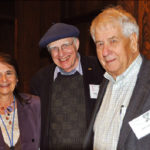This Biography is about one of the best Astrophysicist Joseph Hooton Taylor, Jr. including his Height, weight,Age & Other Detail…
| Biography Of Joseph Hooton Taylor, Jr. | |
| Real Name | Joseph Hooton Taylor, Jr. |
| Profession | Astrophysicists |
| Nick Name | Joseph H. Taylor Jr. |
| Famous as | Nobel Prize Winner in Physics |
| Nationality | American |
| Religion | Quakers |
| Personal life of Joseph Hooton Taylor, Jr. | |
| Born on | 29 March 1941 |
| Birthday | 29th March |
| Age | 76 Years |
| Sun Sign | Aries |
| Born in | Philadelphia |
| Education | Harvard University, Haverford College, Moorestown Friends School |
| Awards | 1993 – Nobel Prize in Physics
1992 – Wolf Prize in Physics 1981 – MacArthur Fellowship – Astronomy 1991 – Albert Einstein Medal 1985 – Henry Draper Medal 1980 – Dannie Heineman Prize for Astrophysics 1991 – John J. Carty Award for the Advancement of Science |
| Personal Fact of Joseph Hooton Taylor, Jr. | |
| Joseph Hooton Taylor Jr. is an American astrophysicist who shared the Nobel Prize in Physics in 1993 for discovering a new type of pulsar that opened up new possibilities for the study of gravitation. He was born in a family, who were Quakers by descent and his parents managed their own farm in Cinnaminson in New Jersey. He studied at the Moorestown Friends School and then at Haverford College, both were Quaker institutions. At school and in college, he showed a remarkable grasp of mathematics.
He earned his doctorate in astronomy from Harvard University and started off as a teacher at the University of Massachusetts. He collaborated with his student Russell A. Hulse to discover the first pulsar in binary system and also proved the presence of gravitational waves a few years later in another paper. After quitting the University of Massachusetts, he became a professor of physics at Princeton University and during his 25 year career at the university; he was made the James S. McDonnell professor of physics and also served as the dean of the physics department for a period. |
|




